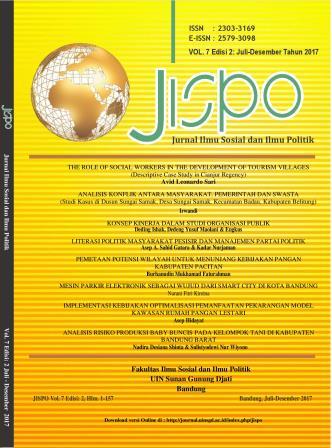IMPLEMENTASI KEBIJAKAN OPTIMALISASI PEMANFAATAN PEKARANGAN MODEL KAWASAN RUMAH PANGAN LESTARI
DOI:
https://doi.org/10.15575/jp.v7i2.2273Keywords:
Policy Implementation, Community Empowerment, Sustainable Food House Area.Abstract
References
Abbeduto, Leonard. (2004). Taking Sides: Clashing Views on Controversial Issues in Educational Psychology Third Edition
McGraw-Hill, Dushkin. Adedokun, O.M. C.W, Adeyamo, and E.O. Olorunsula. (2010) The Impact of Communication on Community Development. J Communication, 1(2): 101-105.
Chalid, Pheni. (2005). Otonomi Daerah Masalah, Pemberdayaan dan Konflik. Penebar Swadaya. Cetakan pertama. Jakarta. Chambers, R. (1985). Rural Development : Putting The Last First. London ; New York.
DANIAL, R. Deni Muhammad. Meningkatkan Keunggulan Bersaing Usaha Kecil Dan Menengah (Umkm). JISPO : Jurnal Ilmu Sosial dan Ilmu Politik, [S.l.], v. 7, n. 1, p. 13 - 21, jun. 2017. ISSN 2579-3098. doi:https://doi.org/10.15575/jp.v7i1.1732.
Dulkiah, M. (2017). Peranan Lembaga Amil Zakat (Laz) Dalam Pemberdayaan Masyarakat Miskin Melalui Pengembangan Usaha Mikro Di Wilayah Jawa Barat. JISPO : Jurnal Ilmu Sosial Dan Ilmu Politik, 7(1), 30 - 49. doi:http://dx.doi.org/10.15575/jp.v7i1.1735
Foy, Nancy. (1994). Empowering People at Work, London: Grower Publishing Company. Friedman, John. (1992). Empowerment The Politics of Alternative Development. Blackwell Publishers, Cambridge, USA. Glasserfield, E. (1987). A Constructivist Approach to Teaching. In L. Steffe & J. Gale (Eds.), Constructivism In Education. Hillsdale, NJ, Lawrence Erlbaum. (pp. 3-16).
Anwar, H. (2016). Pengembangan Umkm Masyarakat Bandung. JISPO : Jurnal Ilmu Sosial Dan Ilmu Politik, 6(1), 102 - 123. doi:http://dx.doi.org/10.15575/jp.v6i1.1752
Ife, J.W.(1995). Community Development: Creating Community Alternatives-vision, Analysiis and Practice. Melbourne : Longman.
Koentjaraningrat. (2009): Manusia dan Kebudayaan di Indonesia. Djambangan. Jakarta.
Longman. Lubis, Hari & Huseini, Martani. (1987). Teori Organisasi; Suatu Pendekatan Makro. Pusat Antar Ilmu-ilmu Sosial UI: Jakarta.
Purwanto, Agus Erwan, (2015), Implementasi Kebijakan Publik, Konsep dan Aplikasinya di Indonesia, Yogyakarta, Peneerbit Gava Media
Pearsons, Talcot. (1991). The Social System. Routledge is an imprint of Taylor & Francis, an informa company.
Parson Wayne, (2006), PolicyPublik Pengantar Teori & Praktik Analisis Kebijakan, Jakarta, Penerbit Prenada Media Group.
Prijono, Onny S. dan Pranarka A.M.W. (ed.). (1996). Pemberdayaan: Konsep, Kebijakan dan Implementasi. Jakarta: Centre for Strategic and International Studies (CSIS). Rusmanto, Joni. (2013). Gerakan Sosial Sejarah Perkembangan Teori Kekuatan dan Kelemahannya. Zifatama Publishing. Sidoarjo. Sadan, Elisheva. (1997). Empowerment and Community Planning: Theory and Practice of People-Focused Social Solutions. Tel Aviv: Hakibbutz Hameuchad Publishers.in Hebrew. [e-book]. Shucksmith, Mark. (2013). Future Direction in Rural Development. Carnegie UK Trust. England. Solichin, Abdul Wahab, (1991), Analisis Kebijaksanaan dari Formulasi ke Implementasi Kebijaksanaan Negara. Jakarta, Penerbit Bumi Aksara. Soetomo. (2006). Strategi-strategi Pembangunan Masyarakat, Yogyakarta: Penerbit Pustaka Pelajar. Suharto E. (2005). Membangun Masyarakat Memberdayakan Rakyat. Kajian Strategi Pembangunan Kesejahteraan Sosial dan Pekerjaan Sosial. Bandung: PT Refika Aditama. Wilson, Terry. (1996). The Empowerment Mannual, London: Grower Publishing Company.
Peraturan Presiden Nomor 22 Tahun 2009, tentang Kebijakan percepatan Penganekaragaman konsumsi pangan .
Peraturan Menteri Pertanian Nomor 43 Tahun 2009 tentang Gerakan Percepatanan Penganekaragaman Konsumsi Pangan
Pedoman pelakssanaan Percepatan Penganekaragaman Konsumsi Pangan ( P2KP ) Tahun 2015-2016 Depdiknas. (2003). Kamus Besar Bahasa Indonesia, Edisi Ketiga, Jakarta: Penerbit Balai Pustaka. Jimu, M.I. 2008. Community Development. Community Development:A Cross-Examination of Theory and Practice Using Experiences in Rural Malawi. Africa Development,Vol. XXXIII, No. 2, 2008, pp. 23–3.
Jasper, James M. 2010. Social Movement Theory Today: Toward a Theory of Action?. Sociology Compass 4/11 (2010): pp.,965-976,10.1111/j.9020.2010.000329.x,.New York: Graduate Center of the City University of New York Mubarak, Z. (2010). Evaluasi Pemberdayaan Masyarakat Ditinjau Dari Proses Pengembangan Kapasitas Pada Program PNPM Mandiri Perkotaan Di Desa Sastrodirjan Kabupaten Pekalongan. Tesis. Program Studi Magister Teknik Pemberdayaan Wilayah Dan Kota. Undip. Semarang. Sukmaniar. (2007). Efektivitas Pemberdayaan Masyarakat Dalam Pengelolaan Program Pengembangan Kecamatan (Ppk) Pasca Tsunami Dikecamatan Lhoknga Kabupaten Aceh Besar. Tesis. UNDIP. Semarang. Sipahelut, Michel. (2010). Analisis Pemberdayaan Masyarakat Nelayan Di Kecamatan Tobelo Kabupaten Halmahera Utara. Tesis. IPB. Bogor.
Downloads
Published
How to Cite
Issue
Section
Citation Check
License
Authors who publish their manuscripts in JISPO agree to the following terms:
- Authors retain copyright and grant the journal right of first publication with the work simultaneously licensed under a Creative Commons Attribution-ShareAlike 4.0 International License that allows others to share the work with an acknowledgment of the work's authorship and initial publication in this journal;
- Authors are able to enter into separate, additional contractual arrangements for the non-exclusive distribution of the journal's published version of the work (e.g., post it to an institutional repository or publish it in a book), with an acknowledgment of its initial publication in this journal; and
- Authors are permitted and encouraged to post their work online (e.g., in institutional repositories or on their websites) after publication process, or prior to and during the submission process, as it can lead to productive exchanges, as well as earlier and greater citation of published work (See The Effect of Open Access).




.jpg)



